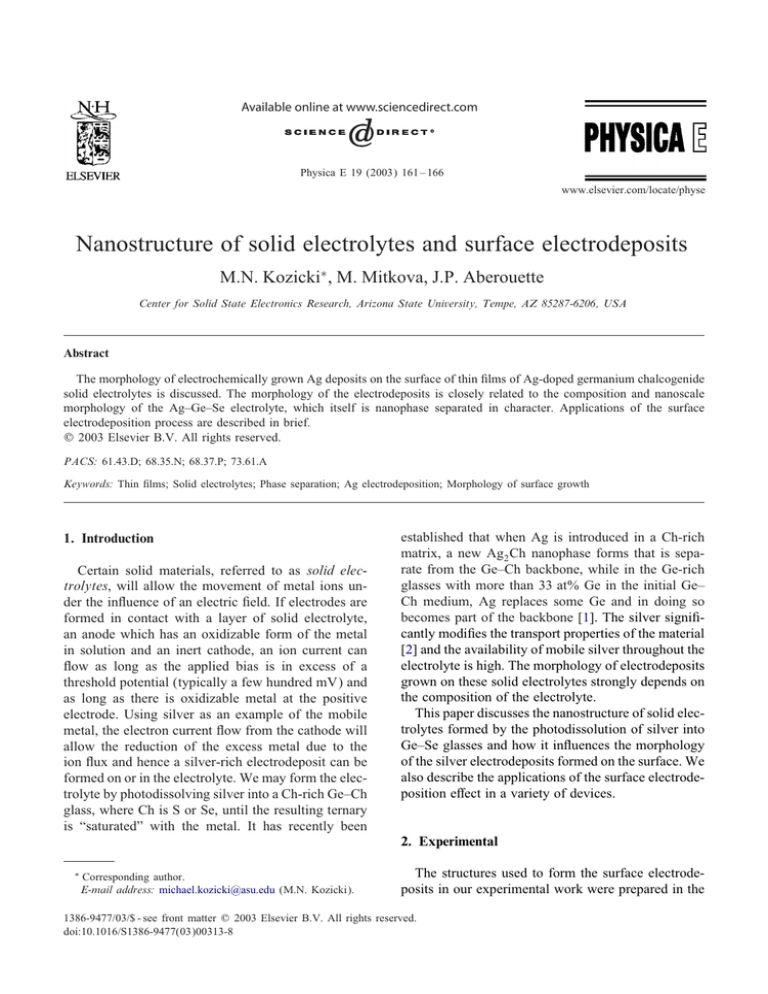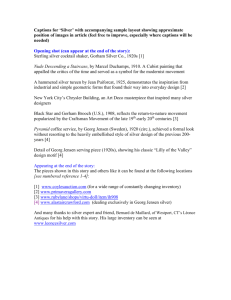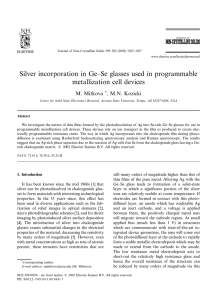
Available online at www.sciencedirect.com
Physica E 19 (2003) 161 – 166
www.elsevier.com/locate/physe
Nanostructure of solid electrolytes and surface electrodeposits
M.N. Kozicki∗ , M. Mitkova, J.P. Aberouette
Center for Solid State Electronics Research, Arizona State University, Tempe, AZ 85287-6206, USA
Abstract
The morphology of electrochemically grown Ag deposits on the surface of thin !lms of Ag-doped germanium chalcogenide
solid electrolytes is discussed. The morphology of the electrodeposits is closely related to the composition and nanoscale
morphology of the Ag–Ge–Se electrolyte, which itself is nanophase separated in character. Applications of the surface
electrodeposition process are described in brief.
? 2003 Elsevier B.V. All rights reserved.
PACS: 61.43.D; 68.35.N; 68.37.P; 73.61.A
Keywords: Thin !lms; Solid electrolytes; Phase separation; Ag electrodeposition; Morphology of surface growth
1. Introduction
Certain solid materials, referred to as solid electrolytes, will allow the movement of metal ions under the in"uence of an electric !eld. If electrodes are
formed in contact with a layer of solid electrolyte,
an anode which has an oxidizable form of the metal
in solution and an inert cathode, an ion current can
"ow as long as the applied bias is in excess of a
threshold potential (typically a few hundred mV) and
as long as there is oxidizable metal at the positive
electrode. Using silver as an example of the mobile
metal, the electron current "ow from the cathode will
allow the reduction of the excess metal due to the
ion "ux and hence a silver-rich electrodeposit can be
formed on or in the electrolyte. We may form the electrolyte by photodissolving silver into a Ch-rich Ge–Ch
glass, where Ch is S or Se, until the resulting ternary
is “saturated” with the metal. It has recently been
∗
Corresponding author.
E-mail address: michael.kozicki@asu.edu (M.N. Kozicki).
established that when Ag is introduced in a Ch-rich
matrix, a new Ag2 Ch nanophase forms that is separate from the Ge–Ch backbone, while in the Ge-rich
glasses with more than 33 at% Ge in the initial Ge–
Ch medium, Ag replaces some Ge and in doing so
becomes part of the backbone [1]. The silver signi!cantly modi!es the transport properties of the material
[2] and the availability of mobile silver throughout the
electrolyte is high. The morphology of electrodeposits
grown on these solid electrolytes strongly depends on
the composition of the electrolyte.
This paper discusses the nanostructure of solid electrolytes formed by the photodissolution of silver into
Ge–Se glasses and how it in"uences the morphology
of the silver electrodeposits formed on the surface. We
also describe the applications of the surface electrodeposition e#ect in a variety of devices.
2. Experimental
The structures used to form the surface electrodeposits in our experimental work were prepared in the
1386-9477/03/$ - see front matter ? 2003 Elsevier B.V. All rights reserved.
doi:10.1016/S1386-9477(03)00313-8
162
M.N. Kozicki et al. / Physica E 19 (2003) 161 – 166
Table 1
Initial !lm
composition
Film composition
occurring after Ag
saturation of the hosting
chalcogenide glass
Amount of
di#used Ag, at%
Amount of Ag
introduced in bulk
glass, at%
Resistance of
the silver-doped
!lm, $
Ge20 Se80
Ge30 Se70
Ge33 Se67
Ge40 Se60
Ge10:5 Se42:3 Ag47:2
Ge18 Se42 Ag40
Ge22:1 Se44:9 Ag33
Ge28 Se42 Ag30
47.2
40
33
30
33
32
20 –30
25
2:21 × 103
43:2 × 103
1:15 × 106
157 × 106
following manner: Silicon substrates covered with a
layer of Si3 N4 deposited by chemical vapor deposi% were cleaned using a
tion to a thickness of 1800 A
%
Piranha etch bath for 5 min. Once cleaned, a 300 A
!lm of chalcogenide glass was deposited followed by
% of silver, deposited without breaking vacuum
150 A
using thermal evaporation. The chalcogenide glass
compositions that are of interest in our investigations
range from Se-rich to Ge-rich—Ge20 Se80 ; Ge30 Se70 ;
Ge33 Se67 and Ge40 Se60 . The samples were illuminated
for 5 min with a light intensity of 4:5 mW=cm2 using a
Karl Suss Mask Aligner model MJB 3UV300, to photodissolve the silver into the chalcogenide !lm. These
conditions have been established to provide saturation
of the chalcogenide !lm with silver. The excess silver
was etched away using a solution of iron nitrate for
1 min. Coplanar silver electrodes spaced 60 !m apart
were patterned on the solid electrolyte using OCG 825
photoresist and a Karl Suss Aligner in a lift-o# process. Silver was deposited using a thermal evaporator
and acetone was used to lift-o# the unwanted silver.
The composition of the Ag-saturated !lm was investigated using Rutherford backscattering spectrometry
(RBS) analysis and the structural con!guration of the
!lms was examined by Raman spectroscopy.
The electrodeposits were formed by applying 5 V
between the electrodes to ensure su&cient current in
the high resistance electrolytes to promote rapid electrodeposition. Morphology, height, and area were established by atomic force microscopy (AFM) using a
Digital Instruments AFM-3 base with a J-head detector in contact mode.
3. Results
The RBS analysis revealed that, as expected, the
photodi#usion changes the overall composition of the
!lms considerably (Table 1). As may be seen from
the table, di#erent amounts of silver are introduced
in the hosting !lms of di#erent composition and the
quantity of di#used silver diminishes with decreasing
Se concentration. Two representative examples of
electrodeposit morphology are shown in Figs. 1 and 2
for Ge30 Se70 and Ge40 Se60 base glasses, respectively.
One can observe substantial di#erences in the
form of the electrodeposits and it is clear that
they depend on the composition of the hosting
glass.
4. Discussion
First we will discuss the formation of the material
on which the growth of the silver electrodeposit takes
place. The strong dependence of the amount of diffused silver at saturation on the composition of the
glasses has been considered by Kluge et al. [3] and
Calas et al. [4] but no substantial explanation has been
given for the e#ect. The most important result is that
the photodi#used !lms are “chemically stable”, i.e.,
once saturated the composition will not change with
continued illumination. In other words, the photodiffusion e#ect is self-limiting. We suggest that this is
due to the intrinsic nature of the structure that forms
in the Ge–Se–Ag system. In the Se-rich compositions,
Ag reacts with the free Se from the Se chains to form
Ag2 Se that phase separates from the Ge–Se backbone.
So the amount of Ag that the system can adopt relates
to the free Se available in the glass. In the bulk glasses,
the amount of silver that can be introduced has been
calculated [1] based on threefold coordination of Ag.
However, we expect that there will be a slight di#erence in the Ag coordination when it is alloyed with Se
to form a glass by fast quenching compared to when
it is introduced by photodi#usion occurring at room
M.N. Kozicki et al. / Physica E 19 (2003) 161 – 166
163
Fig. 1. Atomic force microscope analysis (3D topographical scan and 2D and line scan) of Ag electrodeposit grown on Ag-saturated
Ge30 Se70 . The growth is continuous and the maximum electrodeposit height is a few tens of nm.
temperature. Indeed, this di#erence in the Ag coordination has been enumerated by Oldale et al. [5] in their
extended X-ray absorption !ne structure analysis. We
suggest that this is due to the fact that at quenching
of the alloyed glass, due to the high rate of solidi!cation, the solid phase that forms has a short range
order very close to the structure of the high temperature form—! Ag2 Se, as also has been noted by Barnes
et al. [6]. In contrast, in the di#usion process the phase
that forms has a structure analogous to that of " Ag2 Se
which is stable at room temperature. We assume that
this a#ects the overall coordination of the system and
164
M.N. Kozicki et al. / Physica E 19 (2003) 161 – 166
Fig. 2. Atomic force microscope analysis (3D topographical scan and 2D and line scan) of Ag electrodeposit grown on Ag-saturated
Ge40 Se60 . The growth is discontinuous and the maximum electrodeposit height is in the order of 100 nm.
brings about higher concentration of Ag in the saturated photodi#used thin !lms. In addition, the defects
and metastable states in the chalcogenide that occur
during illumination with band gap light can also react
with silver contributing toward considerable change of
the structure of the hosting glass as revealed by the Raman spectroscopy investigations [7]. For the Ge-rich
glasses it has been shown that Ag becomes part of the
backbone, reacting with units with a distorted rock
salt structure and for bulk glasses formed by quenching of a melt, three component structures form that
include Ag [1]. However since the backbone-altering
reaction requires much more energy, the structure is
much closer packed and so the silver photodi#usion is
M.N. Kozicki et al. / Physica E 19 (2003) 161 – 166
restricted and the overall concentration in the !lm is
reduced. The situation within the stoichiometric compositions is an intermediate one in which Ag can
di#use in pores and volumes between the structural units and react with some charged Se units or
three-dimensional units formed due to the illumination with light.
Now we turn to the electrochemical deposition
of Ag on the Ag-saturated chalcogenide glass. The
general nature of the morphology of these deposits
corresponds closely to those reported in the literature,
particularly those formed by di#usion-controlled processes such as di#usion-limited aggregation (DLA),
described !rst by Forrest and Witten [8]. However
the nucleation points from which the electrodeposits
start to grow are related to the presence of excess Ag
ions in the electrolyte surface as in these regions the
free energy for formation of the electrodeposit will
be lowest. It is therefore obvious why electrodeposit
morphology is dependent on the morphology of the
solid electrolyte. In the case of Ge20 Se80 glasses, the
glass structure is "oppy [9] and the illumination with
light can cause considerable depolymerization of the
Se chains [10]. As a result, a number of randomly
distributed charge defects can occur in which the
photodi#used Ag reacts to form substantial Ag2 Se
regions that later act as nuclei for the formation
of electrodeposits. This, coupled with the high Ag
content of these !lms, is the reason that we observe a great number of randomly distributed Ag
electrodeposits with microscale to nanoscale dimensions covering the surface of the !lms as well as
continuous dendritic structures (not shown in this
paper in the interest of brevity). In the case of
Ge30 Se70 glasses, these have more stressed rigid
structure [11] and illumination with light cannot
cause great redistribution of the existing Se chains.
The phase separation that occurs following Ag photodi#usion therefore results in a well dispersed
nanoscale Ag-rich phase in the ternary. This allows
Ag ion supply for continuous dendrite growth from
the cathode (electron supply) with almost no observable isolated electrodeposition over the surface
(Fig. 1). In the case of the low Ag-content Ge-rich
glasses (Ge40 Se60 ), we assume that any Ag-containing
units can serve as nucleation centers that are electrically isolated from the rest of the !lm because of
the heterogeneous nature of the binary [9] and the
165
considerable di#erence in resistivity in the Ag-rich
and Ag-poor regions [12]. This results in the “isolated” electrodeposits s as shown in Fig. 2. As one
might expect, electrodeposition on the Ag-doped
stoichiometric glass (Ge33 Se67 ) has a morphology
that is between that of Ge30 Se70 and Ge40 Se60 based
electrolytes—the electrodeposits are dendritic but
tend to be discontinuous.
5. Applications of surface electrodeposits
We are currently investigating a range of applications for the various types of surface electrodeposits
described in this paper. The continuous electrodeposits can be used as programmable or renewable
interconnects or electrodes as they may be grown
simply by applying an appropriate bias across a patterned solid electrolyte [13]. Continuous or discontinuous electrodeposits alter the surface properties of the
electrolyte—we have been able to demonstrate water
contact angle increases by as much as 30◦ following electrodeposition. This allows structures based
on this principle to be used as valves in micro"uidic
systems [14]. The presence of electrodeposited silver
can also be used to block or re"ect light and so we
have the possibility of spatial light modulators or
even static displays [15]. Finally, we can also foresee a unique application of the discontinuous “tall”
electrodeposits on Ge-rich electrolytes in microelectromechanical systems as they can be used to lift
or translate mechanical elements by the force of the
electrodeposition normal to the electrolyte surface.
Acknowledgements
The authors acknowledge the !nancial support of
Axon Technologies Corp.
References
[1] M. Mitkova, Y. Wang, P. Boolchand, Phys. Rev. Lett. 83
(1999) 3848.
[2] M.N. Kozicki, M. Yun, S.-J. Yang, J.P. Aberouette, J.P. Bird,
Superlattices Microstruct. 27 (2000) 485.
[3] G. Kluge, A. Thomas, R. Klabes, R. Grotzschel, P. Suptitz,
J. Non-Cryst. Solids 124 (1990) 186.
[4] J. Calas, R. El Ghrandi, G. Galibert, A. Traverse, Nucl.
Instrum. Methods Phys. Res. B 63 (1992) 462.
166
M.N. Kozicki et al. / Physica E 19 (2003) 161 – 166
[5] J.M. Oldale, J. Rennie, S.R. Elliott, Thin Solid Films 164
(1988) 467.
[6] A.C. Barnes, S.B. Lague, P.S. Salmon, H.E. Fisher, J. Phys.:
Condens. Matter 9 (1997) 6159.
[7] M. Mitkova, M.N. Kozicki, J. Non-Cryst. Solids 299 –302
(2002) 1023.
[8] S.R. Forrest, T.A. Witten Jr., J. Phys. A 12 (1972) L109.
[9] P. Boolchand, W. Bresser, Philos. Mag. B 80 (2000) 1757.
[10] A.V. Kolobov, S.R. Elliott, Adv. Phys. 40 (1991) 625.
[11] P. Boolchand, D.G. Georgiev, B. Goodman, J. Optoelectron
Adv. Matter 3 (2001) 703.
[12] Z.U. Borisova, T.S. Rykova, E.Yu. Turkina, A.R. Tabolin,
Inorg. Mater. 20 (1984) 1796 (in Russian).
[13] M.N. Kozicki, US Patent #6,469,364, October 22, 2002; M.N.
Kozicki, US Patent #6,388,324, March 14, 2002.
[14] M.N. Kozicki, P. Maroufkhani, M. Mitkova, Micro"uidic
control systems for biochips, BioDevice Interface Science
and Technology Workshop, Scottsdale, AZ, September
2002.
[15] J.P Aberouette, Optical applications of programmable
metallization cell technology, Masters Thesis, Arizona State
University, June 2002.







